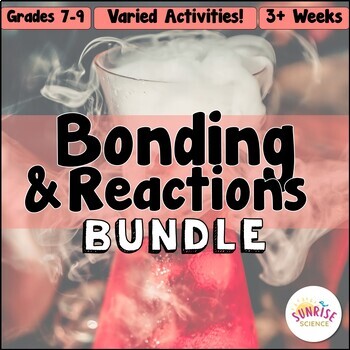Ionic and Covalent Bonding and Chemical Reactions and Balancing Equations Unit
Sunrise Science
12.5k Followers
Grade Levels
8th - 10th, Homeschool
Subjects
Resource Type
Standards
NGSSHS-PS1-1
NGSSHS-PS1-4
NGSSMS-PS1-2
NGSSHS-PS1-5
NGSSHS-PS1-7
Formats Included
- Zip
Pages
400+
Sunrise Science
12.5k Followers

Includes Google Apps™
This bundle contains one or more resources with Google apps (e.g. docs, slides, etc.).
Products in this Bundle (17)
showing 1-5 of 17 products
Bonus
Bonus Chemical Formulas and Electronegativity Lesson
Also included in
- This is a bundle of all of my resources for teaching chemistry concepts at the 8th / 9th grade level, including laboratory equipment and safety, states, properties and changes in matter, atoms and the periodic table, and bonding and chemical reactions. These resources include a mix of Cornell DoodlePrice $195.00Original Price $252.47Save $57.47
Description
Looking for fun and engaging ways to teach your students about chemical bonding and reactions?
This bundle contains 17+ activities (including one *bonus* activity) and 5 assessments to help you teach and assess the following topics:
- Counting Atoms in Chemical Formulas
- Valence Electrons/Lewis Dot Diagrams
- Electronegativity
- Covalent Bonding
- Ions and Ionic Bonding
- Chemical Compounds in Everyday Products
- Modeling Chemical Reactions
- Conservation of Mass
- Endothermic and Exothermic Reactions
- Balancing Chemical Equations
- Types of Chemical Reactions
- Controlling Chemical Reactions
- Bonus!: Chemistry of Smell and Molecular Compounds (the price of this product has been subtracted from the bundle total)
Save 20% by purchasing these activities in this bundle!
An editable PACING GUIDE is included!
Please check out the individual product previews by clicking the preview buttons above for more detailed information about the resources!
Thanks for looking!
Sunrise Science
Total Pages
400+
Answer Key
Included
Teaching Duration
3 Weeks
Report this resource to TPT
Reported resources will be reviewed by our team. Report this resource to let us know if this resource violates TPT’s content guidelines.
Standards
to see state-specific standards (only available in the US).
NGSSHS-PS1-1
Use the periodic table as a model to predict the relative properties of elements based on the patterns of electrons in the outermost energy level of atoms. Examples of properties that could be predicted from patterns could include reactivity of metals, types of bonds formed, numbers of bonds formed, and reactions with oxygen. Assessment is limited to main group elements. Assessment does not include quantitative understanding of ionization energy beyond relative trends.
NGSSHS-PS1-4
Develop a model to illustrate that the release or absorption of energy from a chemical reaction system depends upon the changes in total bond energy. Emphasis is on the idea that a chemical reaction is a system that affects the energy change. Examples of models could include molecular-level drawings and diagrams of reactions, graphs showing the relative energies of reactants and products, and representations showing energy is conserved. Assessment does not include calculating the total bond energy changes during a chemical reaction from the bond energies of reactants and products.
NGSSMS-PS1-2
Analyze and interpret data on the properties of substances before and after the substances interact to determine if a chemical reaction has occurred. Examples of reactions could include burning sugar or steel wool, fat reacting with sodium hydroxide, and mixing zinc with hydrogen chloride. Assessment is limited to analysis of the following properties: density, melting point, boiling point, solubility, flammability, and odor.
NGSSHS-PS1-5
Apply scientific principles and evidence to provide an explanation about the effects of changing the temperature or concentration of the reacting particles on the rate at which a reaction occurs. Emphasis is on student reasoning that focuses on the number and energy of collisions between molecules. Assessment is limited to simple reactions in which there are only two reactants; evidence from temperature, concentration, and rate data; and qualitative relationships between rate and temperature.
NGSSHS-PS1-7
Use mathematical representations to support the claim that atoms, and therefore mass, are conserved during a chemical reaction. Emphasis is on using mathematical ideas to communicate the proportional relationships between masses of atoms in the reactants and the products, and the translation of these relationships to the macroscopic scale using the mole as the conversion from the atomic to the macroscopic scale. Emphasis is on assessing students’ use of mathematical thinking and not on memorization and rote application of problem-solving techniques. Assessment does not include complex chemical reactions.




